
Home - Search - Browse - Alphabetic Index: 0- 1- 2- 3- 4- 5- 6- 7- 8- 9
A- B- C- D- E- F- G- H- I- J- K- L- M- N- O- P- Q- R- S- T- U- V- W- X- Y- Z
STS-41
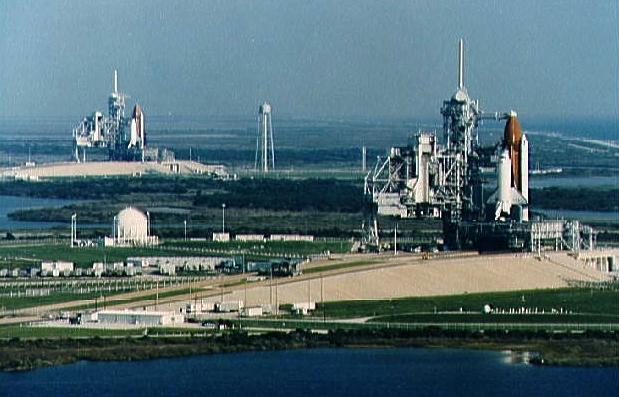
STS-41
Rare view of two space shuttles on adjacent KSC Launch Complex (LC) 39 pads
Credit: NASA
AKA: Discovery. Launched: 1990-10-06. Returned: 1990-10-10. Number crew: 5 . Duration: 4.09 days.
Payloads: Deploy Ulysses, Shuttle Solar Backscatter Ultraviolet, Intelsat Solar Array Coupon, Solid-Surface Combustion Experiment, Investigations Into Polymer Membrane Processing, Chromo-some and Plant Cell Division in Space, Physiological Systems Experiment, Voice Command System, Radiation Monitoring Equipment III, Air Force Maui Optical Site.
Orbits of Earth: 65. Distance traveled: 2,747,866 km. Orbiter Liftoff Mass: 132,911 kg. Orbiter Mass at Landing: 89,803 kg. Payload to Orbit: 22,140 kg. Payload Returned: 4,662 kg. Landed at: Concrete runway 22 at Edwards Air Force Base, Cali. Landing Speed: 359 kph. Touchdown miss distance: 699 m. Landing Rollout: 2,600 m.
NASA Official Mission Narrative
Mission Name: STS-41 (36)
DISCOVERY (11)
Pad 39-B (15)
36th Shuttle mission
11th Flight OV-103
Crew:
Richard N. Richards (2), Commander
Robert D. Cabana (1), Pilot
William M. Shepherd (2), Mission Specialist 1
Bruce E. Melnick (1), Mission Specialist 2
Thomas D. Akers (1), Mission Specialist 3
Milestones:
OPF - May 8, 1990
VAB - Aug. 27, 1990
PAD - Sept. 4, 1990
Payload:
ULYSSES,SSBUV-02,ISAC
Mission Objectives:
Launch:
October 6, 1990, 7:47:15 a.m. EDT. Liftoff occurred 12 minutes after two-and-a-half-hour launch window opened at 7:35 a.m. EDT, Oct.6. Heaviest payload to date. Launch Weight: 259,593 lbs.
Orbit:
Altitude: 160nm
Inclination: 28.45 degrees
Orbits: 66
Duration: 4 days, 2 hours, 10 minutes, 4 seconds.
Distance: 1,707,445 miles
Hardware:
SRB: BI-040
SRM: 360Q013
ET : 39/LWT-32
MLP : 2
SSME-1: SN-2011
SSME-2: SN-2031
SSME-3: SN-2107
Landing:
October 10, 1990, 6:57:18 a.m. PDT, Runway 22, Edwards Air Force Base, Calif. Rollout distance: 8,276 feet. Rollout time: 49 seconds (braking test). Orbiter returned to KSC Oct. 16,1990. Landing Weight: 196,869 lbs.
Mission Highlights:
Primary payload, ESA-built Ulysses spacecraft to explore polar regions of Sun, deployed. Two upper stages, Inertial Upper Stage (IUS) and a mission-specific Payload Assist Module-S (PAM-S), combined together for first time to send Ulysses toward out-of- ecliptic trajectory. Other payloads and experiments: Shuttle Solar Backscatter Ultraviolet (SSBUV) experiment; INTELSAT Solar Array Coupon (ISAC); Chromosome and Plant Cell Division Experiment (CHROMEX); Voice Command System (VCS); Solid Surface Combustion Experiment (SSCE), Investigations into Polymer Membrane Processing (IPMP); Physiological Systems Experiment (PSE); Radiation Monitoring Experiment III (RME III); Shuttle Student involvement Program (SSIP) and Air Force Maui Optical Site (AMOS) experiment.
More at: STS-41.
Family: Manned spaceflight. People: Akers, Cabana, Melnick, Richards, Shepherd. Country: USA. Spacecraft: Discovery. Projects: STS. Launch Sites: Cape Canaveral. Agency: NASA, NASA Houston.
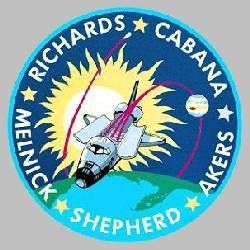 | STS-41 Credit: www.spacefacts.de |
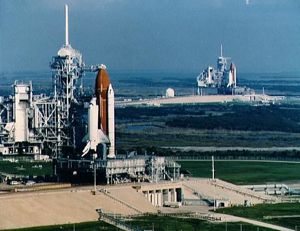 | STS-41 Rare view of two space shuttles on adjacent KSC Launch Complex (LC) 39 pads Credit: NASA |
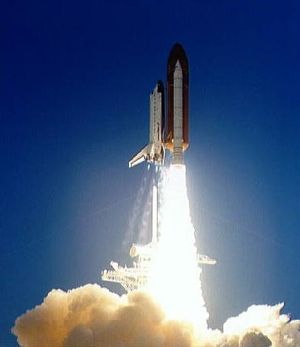 | STS-41 STS-41 Discovery, OV-103, lifts off from KSC Launch Complex (LC) Pad 39 Credit: NASA |
 | STS-41 STS-41 external tank (ET) falls back to Earth after release from OV-103 Credit: NASA |
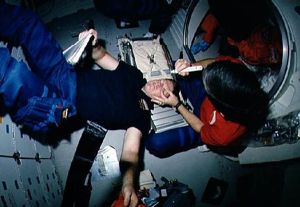 | STS-41 STS-41 crewmembers conduct DSO 0472 Intraocular Pressure on OV-103's middeck Credit: NASA |
 | STS-41 STS-41 ISAC deployed on remote manipulator system (RMS) lower arm boom Credit: NASA |
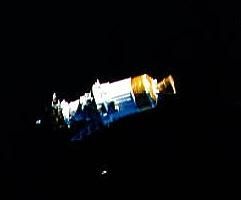 | STS-41 Ulysses spacecraft and its upper stage system are deployed during STS-41 Credit: NASA |
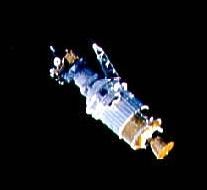 | STS-41 Ulysses spacecraft and its upper stage system are deployed during STS-41 Credit: NASA |
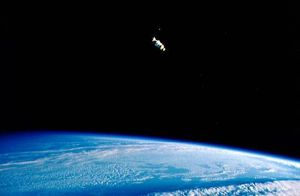 | STS-41 Ulysses spacecraft and its upper stage system are deployed during STS-41 Credit: NASA |
1990 October 6 - . 11:47 GMT - . Launch Site: Cape Canaveral. Launch Complex: Cape Canaveral LC39B. Launch Platform: MLP2. LV Family: Shuttle. Launch Vehicle: Space Shuttle.
- STS-41 - .
Call Sign: Discovery. Crew: Akers,
Cabana,
Melnick,
Richards,
Shepherd.
Payload: Discovery F11 / Ulysses [IUS + PAM-S]. Mass: 22,140 kg (48,810 lb). Nation: USA.
Related Persons: Akers,
Cabana,
Melnick,
Richards,
Shepherd.
Agency: NASA Houston.
Program: STS.
Class: Manned.
Type: Manned spaceplane. Flight: STS-41.
Spacecraft Bus: Shuttle.
Spacecraft: Discovery.
Duration: 4.09 days. Decay Date: 1990-10-10 . USAF Sat Cat: 20841 . COSPAR: 1990-090A. Apogee: 307 km (190 mi). Perigee: 300 km (180 mi). Inclination: 28.50 deg. Period: 90.60 min.
Manned five crew. Deployed Ulysses spacecraft. Payloads: Deploy Ulysses, Shuttle Solar Backscatter Ultraviolet, Intelsat Solar Array Coupon, Solid-Surface Combustion Experiment, Investigations Into Polymer Membrane Processing, Chromo-some and Plant Cell Division in Space, Physiological Systems Experiment, Voice Command System, Radiation Monitoring Equipment III, Air Force Maui Optical Site.
1990 October 7 - .
- STS-41 - Wakeup Song: Rise and Shine, Discovery! - .
Flight: STS-41.
"Rise and Shine, Discovery!" written and performed by Boeing Aerospace & Electronics Co. Employees as a tribute to the successful deployment of the Ulysses probe, using a Boeing built booster. Sung by the Boeing Employees Choir. Michael Kysar, Boeing Choir Director, and Gloria Ball, choir member, collaborated on words and music. It includes the refrain: Sailing along, sailing along, flying to explore the galaxy.
1990 October 8 - .
- STS-41 - Wakeup Song: Semper Paratus - . Flight: STS-41. "Semper Paratus" (Always Ready) by The Coast Guard Band in honor of Bruce Melnick, the first Coast Guard member to fly in space..
1990 October 9 - .
- STS-41 - Wakeup Song: Fanfare for the Common Man - . Flight: STS-41. "Fanfare for the Common Man" written by Aaron Copland ,one of copilot Robert Cabana's favorites, followed by: The University of Missouri Fight Song, to pay homage to commander Richard Searfoss' alma mater. CAPCOM: Story Musgrave.
1990 October 10 - .
- STS-41 - Wakeup Song: The Highwayman - . Flight: STS-41. "The Highwayman" by The Highwaymen (Kris Kristofferson, Willie Nelson, Waylon Jennings, and Johnny Cash). For Thomas Akers, a fan of country music..
1990 October 10 - .
- Landing of STS-41 - . Return Crew: Akers, Cabana, Melnick, Richards, Shepherd. Nation: USA. Related Persons: Akers, Cabana, Melnick, Richards, Shepherd. Program: STS. Flight: STS-41. STS-41 landed at 13:55 GMT. .
Back to top of page
Home - Search - Browse - Alphabetic Index: 0- 1- 2- 3- 4- 5- 6- 7- 8- 9
A- B- C- D- E- F- G- H- I- J- K- L- M- N- O- P- Q- R- S- T- U- V- W- X- Y- Z
© 1997-2019 Mark Wade - Contact
© / Conditions for Use